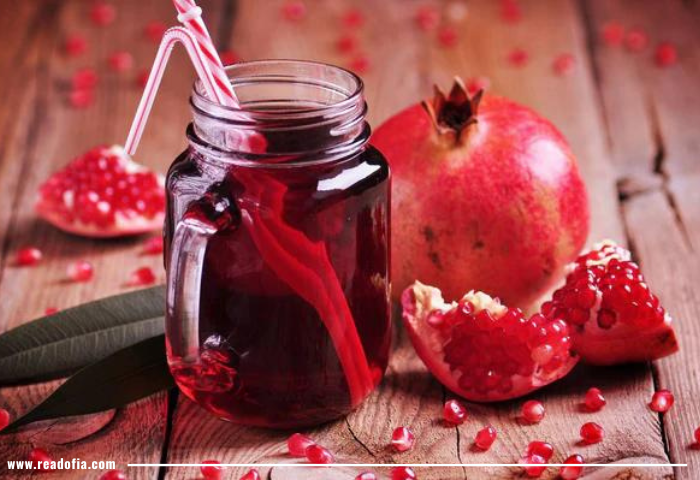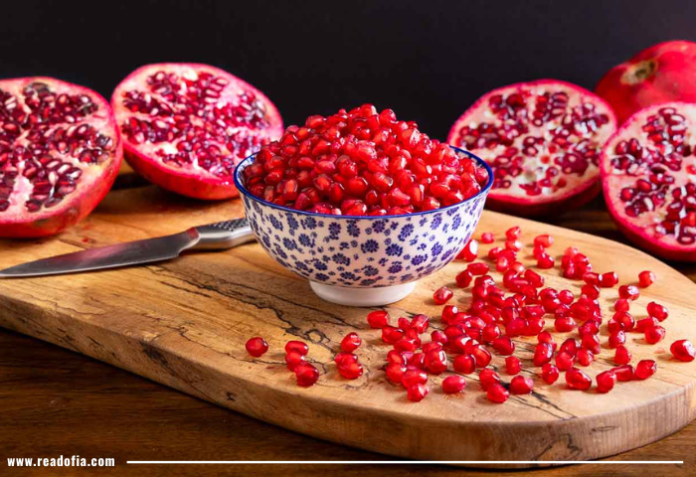Pomegranate is one of the Long living small trees globally; it has a life expectancy of over 200 years. Wow !! That’s great !! They grow at the height of around 16 to 33 feet with multiple branches. It can be eaten normally or added to salads, cocktails, oat meals , and other rice-based entrees. A glass of pomegranate fruit juice is loaded with healthy nutritions.Pomegranate Fruit Nutrition Facts – healthiest red-colored fruit.
Flowers
Pomegranate leaves are bright red, with three to seven petals in them. The Pomegranate (Punica granatum) is a shrub in the Lythraceae family that produces the healthiest red-colored fruit. Pomegranates are rich in vitamins, minerals, fiber, and potent plant compounds. It’s a sweet fruit with thick red skin and hundreds of edible juicy seeds called arils.

Juice
Some fruits are sweet, and some taste sour. It depends on the variety of the pomegranate types. Drinking Pomegranate juice is a habit in Europe and Middle Eastern countries. It is more popular in the USA, Canada, and India. The pomegranate fruit includes substances with antioxidant and anti-inflammatory activity, and it helps reduce more health-related diseases.

Types in India
Important pomegranate varieties cultivated in India are Alandi or Vadki, Dholka, Kandhari, Kabul, Muskati Red, Paper Shelled, Spanish Ruby, Ganesh (GB I), G 137, P 23, P 26, Mridula, Aarakta, Jyoti, Ruby, IIHR Selection, Yercaud 1 and Co 1.
According to the USDA data, the nutritional value of pomegranate (100g) are as follows.
| Nutrient | Value |
| Calories | 83 g |
| Carbohydrate | 18.7 g |
| Sugars | 13.67 g |
| Water | 78 g |
| Fiber | 4 g |
| Protein | 1.67 g |
| Fat | 1.17 g |
Vitamins
According to the USDA data, vitamins and their quantity in pomegranate (100g) are as follows.
| Vitamins | Quantity |
| Thiamine (B1) | 0.067 mg |
| Riboflavin (B2) | 0.053 mg |
| Niacin (B3) | 0.293 mg |
| Pantothenic acid (B5) | 0.377 mg |
| Vitamin B6 | 0.075 mg |
| Folate (B9) | 38 µg |
| Choline 7.6 mg | 7.6 mg |
| Vitamin C | 10.2 mg |
| Vitamin E | 0.6 mg |
| Vitamin K | 16.4 µg |
Minerals
According to the USDA data, minerals and their quantity in pomegranate (100g) are as follows.
| Minerals | Quantity |
| Calcium | 10 mg |
| Iron | 0.3 mg |
| Magnesium | 12 mg |
| Manganese | 0.119 mg |
| Phosphorus | 36 mg |
| Potassium | 236 mg |
| Sodium | 3 mg |
| Zinc | 0.35 mg |
Health benefits
- Reduce inflammation and the effects of aging
Lowers blood pressure and improves heart health
Help to fight against prostate cancer
Improve memory
Improve exercise performance
Help fight arthritis and joint pain
Lowers the risk of diabetes.
FAQ
What plant compounds in pomegranate is responsible for health benefit?
Pomegranates contain two powerful plant compounds called punicalagin and punicic acid. These unique substances in pomegranates are responsible for most of their health benefits.
Is pomegranate juice provides health benefits?
Pomegranate juice helps in reducing blood pressure, which is a primary factor for heart disease. It is also packed with powerful anti-inflammatory properties.
Can dogs eat Pomegranates?
Pomegranates are rich in Antioxidants, which lowers the dogs’ heart diseases. But there is a substance called Tannis, which dogs can react in pomegranates; it makes the dogs stomach upset and creates diarrhea and vomiting.
How to tell if a pomegranate is ripe?
According to professionals, the weight of the pomegranate fruit is one of the practical ways to know the ripeness. But some other factors in determining the ripeness of the Pomegranate include shape, color, texture, and tapping of the fruit.
What are the side effects of eating pomegranate seeds?
Chemicals in pomegranate juice might slow the advancement of hardening of the arteries is a lesser-known side effect of eating pomegranate seeds. On the other side, drinking pomegranate juice is not known scientifically yet.
How to get pomegranate seeds out?
After cutting the Pomegranate into three to four pieces, tap it using a silver spoon or wooden stick gently on its outer surface. As a result, seeds in the pomegranate seeds will fall gently !!
How to make Juice a pomegranate?
After taking all the seeds from a pomegranate, mix it well and put it in the mixer to Juice it. Add some water, if needed. Some people add milk to the pomegranate juice to make it thicker and less sour taste. It depends on the varieties of the pomegranates.
How many pomegranate seeds did Persephone eat? What is the myth behind her abductivity?
According to the Greek myth, Pomegranate represents the Life, Regeneration, and Marriage. In Many religions, such as Christianity, Zoroastrianism, Buddhism, Judaism, Islam, pomegranate represents the sacred fruit of all time. Coming to the Greek Myth, Hades, the Underworld Lord, abducts Persephone while plugging the flowers outside in the field; at the time, Hades was mesmerized by her beauty and abducted her. Persephone ate a few pomegranate seeds and tied herself to Hades. By knowing this news, Corn goddess Demeter prevented the earth from bearing the pomegranate fruit until she saw her daughter Persephone. Later Zeus made a compromise between Demeter and Hades. As a result, Persephone should live 1/3rd of days in the year with Hades and the rest with Corn Goddess Demeter. The Greek world celebrates the return of Persephone to the Demeter by the arrival of the Spring season.
How to store Pomegranate seeds?
Stock it in a cool, dry, well-ventilated place. Pomegranate fruit should be spread on tables or dangled by connecting strings to the fruit stems.
Is pomegranate juice good for your kidneys?
Pomegranate is rich in antioxidants, which play a vital role in keeping your heart healthy. At the same time, it lowers high blood pressure and reduces the risk of Diabetes. Both High Blood pressure and Diabetes are the prolonged reason for kidney failure.
Can I eat Pomegranate in pregnancy?
Pomegranate seeds are rich in Antioxidants, Vitamin K, Folate(B9), Vitamin C. It is a healthy choice to eat in pregnancies. (Avoid added sugar while preparing pomegranate juice)

